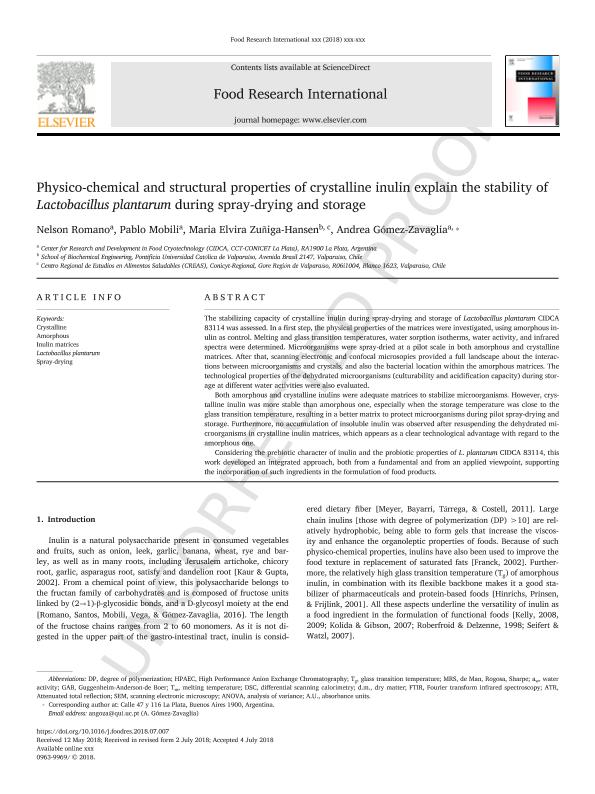Mostrar el registro sencillo del ítem
dc.contributor.author
Romano, Nelson Gastón

dc.contributor.author
Mobili, Pablo

dc.contributor.author
Zuñiga Hansen, Maria Elvira
dc.contributor.author
Gomez Zavaglia, Andrea

dc.date.available
2020-01-09T18:56:03Z
dc.date.issued
2018-11
dc.identifier.citation
Romano, Nelson Gastón; Mobili, Pablo; Zuñiga Hansen, Maria Elvira; Gomez Zavaglia, Andrea; Physico-chemical and structural properties of crystalline inulin explain the stability of Lactobacillus plantarum during spray-drying and storage; Elsevier Science; Food Research International; 113; 11-2018; 167-174
dc.identifier.issn
0963-9969
dc.identifier.uri
http://hdl.handle.net/11336/94171
dc.description.abstract
The stabilizing capacity of crystalline inulin during spray-drying and storage of Lactobacillus plantarum CIDCA 83114 was assessed. In a first step, the physical properties of the matrices were investigated, using amorphous inulin as control. Melting and glass transition temperatures, water sorption isotherms, water activity, and infrared spectra were determined. Microorganisms were spray-dried at a pilot scale in both amorphous and crystalline matrices. After that, scanning electronic and confocal microsopies provided a full landscape about the interactions between microorganisms and crystals, and also the bacterial location within the amorphous matrices. The technological properties of the dehydrated microorganisms (culturability and acidification capacity) during storage at different water activities were also evaluated. Both amorphous and crystalline inulins were adequate matrices to stabilize microorganisms. However, crystalline inulin was more stable than amorphous one, especially when the storage temperature was close to the glass transition temperature, resulting in a better matrix to protect microorganisms during pilot spray-drying and storage. Furthermore, no accumulation of insoluble inulin was observed after resuspending the dehydrated microorganisms in crystalline inulin matrices, which appears as a clear technological advantage with regard to the amorphous one. Considering the prebiotic character of inulin and the probiotic properties of L. plantarum CIDCA 83114, this work developed an integrated approach, both from a fundamental and from an applied viewpoint, supporting the incorporation of such ingredients in the formulation of food products.
dc.format
application/pdf
dc.language.iso
eng
dc.publisher
Elsevier Science

dc.rights
info:eu-repo/semantics/openAccess
dc.rights.uri
https://creativecommons.org/licenses/by-nc-sa/2.5/ar/
dc.subject
AMORPHOUS
dc.subject
CRYSTALLINE
dc.subject
INULINE MATRICES
dc.subject
LACTOBACILLUS PLANTARUM
dc.subject
SPRAY-DRYING
dc.subject.classification
Alimentos y Bebidas

dc.subject.classification
Otras Ingenierías y Tecnologías

dc.subject.classification
INGENIERÍAS Y TECNOLOGÍAS

dc.subject.classification
Biología Celular, Microbiología

dc.subject.classification
Ciencias Biológicas

dc.subject.classification
CIENCIAS NATURALES Y EXACTAS

dc.subject.classification
Alimentos y Bebidas

dc.subject.classification
Otras Ingenierías y Tecnologías

dc.subject.classification
INGENIERÍAS Y TECNOLOGÍAS

dc.title
Physico-chemical and structural properties of crystalline inulin explain the stability of Lactobacillus plantarum during spray-drying and storage
dc.type
info:eu-repo/semantics/article
dc.type
info:ar-repo/semantics/artículo
dc.type
info:eu-repo/semantics/publishedVersion
dc.date.updated
2019-10-15T14:12:36Z
dc.journal.volume
113
dc.journal.pagination
167-174
dc.journal.pais
Países Bajos

dc.journal.ciudad
Amsterdam
dc.description.fil
Fil: Romano, Nelson Gastón. Consejo Nacional de Investigaciones Científicas y Técnicas; Argentina. Provincia de Buenos Aires. Gobernación. Comisión de Investigaciones Científicas. Centro de Investigación y Desarrollo en Criotecnología de Alimentos. Consejo Nacional de Investigaciones Científicas y Técnicas. Centro Científico Tecnológico Conicet - La Plata. Centro de Investigación y Desarrollo en Criotecnología de Alimentos. Universidad Nacional de la Plata. Facultad de Ciencias Exactas. Centro de Investigación y Desarrollo en Criotecnología de Alimentos; Argentina
dc.description.fil
Fil: Mobili, Pablo. Consejo Nacional de Investigaciones Científicas y Técnicas; Argentina. Provincia de Buenos Aires. Gobernación. Comisión de Investigaciones Científicas. Centro de Investigación y Desarrollo en Criotecnología de Alimentos. Consejo Nacional de Investigaciones Científicas y Técnicas. Centro Científico Tecnológico Conicet - La Plata. Centro de Investigación y Desarrollo en Criotecnología de Alimentos. Universidad Nacional de la Plata. Facultad de Ciencias Exactas. Centro de Investigación y Desarrollo en Criotecnología de Alimentos; Argentina
dc.description.fil
Fil: Zuñiga-Hansen, Maria Elvira. Centro Regional de Estudios En Alimentos Saludables, Valparaiso; Chile. Pontificia Universidad Católica de Valparaíso;Chile; Argentina
dc.description.fil
Fil: Gomez-Zavaglia, Andrea. Provincia de Buenos Aires. Gobernación. Comisión de Investigaciones Científicas. Centro de Investigación y Desarrollo en Criotecnología de Alimentos. Consejo Nacional de Investigaciones Científicas y Técnicas. Centro Científico Tecnológico Conicet - La Plata. Centro de Investigación y Desarrollo en Criotecnología de Alimentos. Universidad Nacional de la Plata. Facultad de Ciencias Exactas. Centro de Investigación y Desarrollo en Criotecnología de Alimentos; Argentina
dc.journal.title
Food Research International

dc.relation.alternativeid
info:eu-repo/semantics/altIdentifier/url/https://www.sciencedirect.com/science/article/pii/S0963996918305350
dc.relation.alternativeid
info:eu-repo/semantics/altIdentifier/doi/https://doi.org/10.1016/j.foodres.2018.07.007
Archivos asociados
